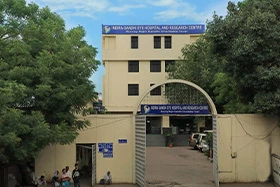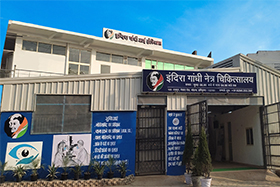- Centurion Phacoemulsification Vision System
- Infiniti Phacoemulsification Vision System
- Zeiss Lumera Operating Microscopes
- A Scan Biometry: Zeiss IOL Master 700
- B Scan Ultrasonography
- Email: enquiry@indiragandhieyehospital.com
- Call: 01242710271
Specialties
Cataract Surgery in Lucknow
The Department of Cataract and General Ophthalmology, renowned for providing the best in class Cataract Surgery in Lucknow, offers a wide range of treatments in northern India. This department boasts a team of experienced and acclaimed surgeons, who are experts in all kinds of advanced Cataract microsurgery procedures, setting a high standard for Cataract Treatment in Lucknow.
Additionally, the department serves as a Cataract surgery training centre, where numerous ophthalmologists have been skillfully trained in various modalities of Cataract surgery since its inception, further reinforcing its leading position in eye care services.

Technical set up
- Keratometer
- Pentacam: Corneal topography
- Retinal Acuity Meter (RAM): Macular function
- Pachymetry
- I TRACE Aberrometry
- FD OCT
- Anterior segment digital photography
- Dry eye disorders estimation
- Specular microscopy
Treatment available
The department offers to the efficient diagnosis and management of a wide range of diseases:
- Senile Cataracts
- Developmental Cataracts
- Posterior Polar Cataracts
- Traumatic Cataracts
- Subluxated and Dislocated Cataracts: Cionni ring, Segments and CTR implantation
- Complicated cataracts with uveitis
- Complicated cataracts with glaucoma
- Combined Cataract and Retina Surgeries
- Secondary IOL implantation
- Management of Aphakia
- Cataracts with Microcornea and Colobomas of Iris, Lens and Retina-choroid
- Refractive errors management with CLE
- Iris-Fixated Intraocular lenses
- Aniridia IOLs
- Pupillary Reconstruction surgeries
- Management of Refractive errors
Procedures or surgeries
The department has an array of surgeries to offer and provide most recent advances in the field of Cataract surgery which include:
Topical Microincision Cataract Surgery (MICS) with Foldable MULTIFOCAL / TRIFOCAL / TORIC AND TORIC MULTIFOCAL Intra Ocular Lens Implantation: Cataract surgery is performed without injection by the latest & most advanced Centurion Phacoemulsification vision system from a 2.2 mm incision and a foldable Multifocal/ Trifocal/ Toric / Toric Multifocal lens implanted .
Topical Microincision Cataract Surgery (MICS) with Foldable EDOF Intra Ocular Lens Implantation:Cataract surgery without injection by Centurion Phacoemulsification vision system from a 2.2 mm incision and a foldable Extended Depth Of Focus (EDOF) lens implanted
Traumatic Subluxated Cataracts:Cataract surgeries with inadequate Zonular support ; Cionni Ring, Segments or Capsular Tension Rings are implanted with Foldable IOLs. Wound exploration and reconstruction in cases of Penetrating trauma with cataract.
Management of Aphakia with Secondary IOLs: Scleral Tuck IOLs, Iris Fixated IOLs
Secondary Management of Surgical complications in cases referred from elsewhere: Our Surgical team has special expertise in the management of surgical complications of patients referred from outside
Small Incision Sutureless Cataract Surgery: An excellent quality surgery in high volumes of Outreach community cases
The department is equipped with microbiological and histopathological evaluations: of diseases of external eye diseases




